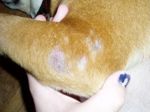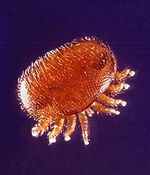Difference between revisions of "Mites"
| Line 17: | Line 17: | ||
'''[[Non-Burrowing Mites]] | '''[[Non-Burrowing Mites]] | ||
| + | '''[[Forage Mites]] | ||
| − | |||
| − | |||
| − | |||
| − | |||
| − | |||
| − | |||
| − | |||
| − | |||
| − | |||
| − | |||
Revision as of 22:50, 5 April 2010
| This article has been peer reviewed but is awaiting expert review. If you would like to help with this, please see more information about expert reviewing. |
Astigmata (mites) introduction
Mites are one of the most successful and diverse vertebrate groups. The species of veterinary importance are parasitic, although a few non-parasitic mites are also important, such as oribatid mites (intermediate hosts for Anoplocephala and Moniezia) and forage mites.
Mites are very small, on average under 0.3mm in length and for this reason often go unnoticed. They spend the majority of their life cycle on the host and cause mange.
The body shows no segmentation but can be divided into two sections, the idiosoma and the gnathosoma. Adult and nymphs have four pairs of legs, whereas larvae have only three pairs of legs.
The taxonomy of mites is complex as there are over 8 families. In this article the families are split according to their location on the host into sub-surface (burrowing) and surface (non-burrowing) mites.
Varroa destructor
- More commonly known as the honeybee mite
- Notifiable disease in the UK
- Oval
- 1-1.5mm in length
- Eggs are laid in the hive and develop with the brood cells
Pathogenesis
- Blood-sucking
- Weakens adult bees
- Damages growing larval bees resulting in deformities
Control
- Acaricidal strips hung between combs
- Destroy colonies in apiary (if isolated outbreak)
- Monitor mite numbers and treat if widespread


